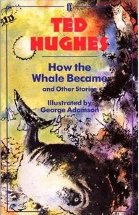How the whale became and other stories by Ted Hughes

Faber and Faber, 2011 (1963). ISBN 978 0512744208.
(Ages 6+) Recommended. Storytelling. I was constantly reminded of my
favourite childhood book, the Just so stories, by Rudyard
Kipling, while reading this small volume of Ted Hughes' wonderful
animal legends. First published in 1963, the eleven stories of how
things came to be will evoke humour and a lasting interest in the
idea of storytelling. Hughes, Poet Laureate from 1984 until his
death in 1998, was one of England's favourite poets and children's
authors. And this book, How the whale became, exposes his
considerable talent to a new audience.
The stories show the animals at the beginning of time, wondering
what they will become in the world. Many try different things, until
they hit upon the animal they should be. Readers will roar with
laughter at the donkey trying to be a lion, an eagle, a bull and a
cockatoo, all giving them five minutes each, before hitting on being
a donkey.
The whale grows up in God's vegetable patch but in growing so large,
squashed God's carrots and so was banished to the sea. The polar
bear is lured out of the polar regions because it always wins the
beauty contests and the other animals are jealous. And so on. Each
creation story revolves a big issue, jealousy, independence,
conformity, and each is fun to read aloud or in a group. Bordering
on fables, the stories could well be used in a unit in the classroom
on storytelling, or fables, or creation stories, or to introduce a
study of animals, or just to have fun.
Fran Knight